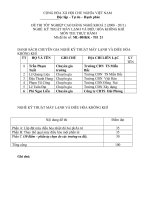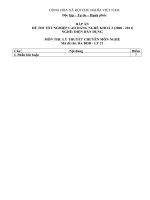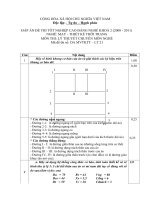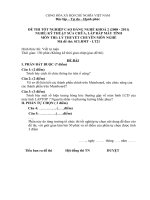Lecture Connections 21 | Lipid Biosynthesis
Bạn đang xem bản rút gọn của tài liệu. Xem và tải ngay bản đầy đủ của tài liệu tại đây (3.52 MB, 69 trang )
Lecture Connections
21 | Lipid Biosynthesis
© 2009 W. H. Freeman and Company
CHAPTER 21
Lipid Biosynthesis
Key topics:
– Biosynthesis of fatty acids and eicosanoids
– Biosynthesis of triacylglycerols
– Biosynthesis of fatty cholesterol
Lipids Fulfill a Variety of
Biological Functions
•
•
•
•
•
•
•
•
•
Storage of energy
Constituents of cellular membranes
Anchors for membrane proteins
Cofactors for enzymes
Signaling molecules
Pigments
Detergents
Transporters
Antioxidants
Catabolism and Anabolic of Fatty
Acids Proceed via Different
Pathways
• Catabolism of fatty acids
– produced acetyl-CoA
– reducing power to NADH
– location: mitochondria
• Anabolism of fatty acids
– requires malonyl-CoA and acetyl-CoA
– reducing power from NADPH
– location: cytosol in animals, chloroplast in plants
Lipid Catabolism and Anabolism in
Animal and Plant Cells
Overview of Fatty Acid Synthesis
• Fatty acids are built in several passes
processing one acetate unit at a time
• The acetate is coming from activated malonate
in the form of malonyl-CoA
• In each pass involves reduction of a carbonyl
carbon to a methylene carbon
Overview of Fatty Acid Synthesis
Synthesis of Malonyl-CoA (1)
• The three-carbon precursor for fatty acid
synthesis is made from acetyl-CoA and CO2
• The reaction is catalyzed by acetyl-CoA
carboxylase (ACC)
• ACC is a bifunctional enzyme
– Biotin carboxylase
– Transcarboxylase
• ACC contains biotin, nature’s carrier of CO2
– Biotin shuttles between the two active sites
Synthesis of Malonyl-CoA (2)
• Bicarbonate reacts with the terminal phosphate
of ATP to give carbamoyl phosphate
• Biotin carries out a nucleophilic attack to
carbamoyl phosphate
• The product is a good donor of a carboxylate
group
Synthesis of Malonyl-CoA (3)
• The arm swing moves carboxybiotin to the
transcarboxylase site
• Terminal methyl of acetyl-CoA probably
deprotonates to give a resonance-stabilized
carbanion
• The carbanion picks up the carboxylate moiety
from biotin
Fatty Acid Synthesis
• Overall goal is to attach a two-carbon acetate unit from
malonyl-CoA to a growing chain and then reduce it
• Reaction involves cycles of four enzyme-catalyzed steps
– Condensation of the growing chain with activated acetate
– Reduction of carbonyl to hydroxyl
– Dehydration of alcohol to trans-alkene
– Reduction of alkene to alkane
• The growing chain is initially attached to the enzyme via
a thioester linkage
• During condensation, the growing chain is transferred to
the acyl carrier protein
• After the second reduction step, the elongated chain is
transferred back to fatty acid synthase
Acyl Carrier Protein
• Contains a covalently attached prothetic group 4’phospho-pantethiene
• The acyl carrier protein delivers acetate (in the
first step) or malonate (in all the next steps) to the
fatty acid synthase
• The acyl carrier protein shuttles the growing chain
from one active site to another during the fourstep reaction
Charging the Acyl Carrier Protein
and Fatty Acid Synthase
• Two thiols participate in the fatty acid synthesis
– Thiol from 4-phosphopantethine in acyl carrier protein
– Thiol from cysteine in fatty acid synthase
• Both thiols must be charged for the condensation
reaction to occur
– In the first step, acetyl from acetyl-CoA is transferred to
acyl carrier protein
– Acyl carrier protein passes this acetate to fatty acid
synthase
– Acyl carrier protein is then re-charged with malonyl
from malonyl-CoA
Assimilation of Two-Carbon Units
Condensation and First Reduction
Assimilation of Two-Carbon Units
Dehydration and Second Reduction









